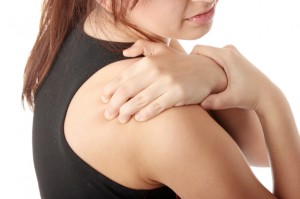
Definition
Subacromial impingement describes a group of conditions which are driven by the compression, irritation and subsequent inflammation of the structures between the humeral head (upper arm bone) and the acromion (tip of the shoulder).
The structures most commonly affected in impingement are the tendons of the rotator cuff muscles, but this condition can also affect any other structure in the subacromial space such as the tendon of the long head of biceps, the joint capsule and or the bursa.
Subacromial impingement may precede, follow or occur simultaneously with a rotator cuff tendinopathy. This describes a degenerative condition of the tendons of the rotator cuff muscles. Tendinopathy can fall anywhere along a large spectrum of pathology; from a low grade inflammatory disorder to an advanced degenerative state where partial or full thickness tears may be present.
- Pain at the front or tip of the shoulder; may or may not refer into the upper arm
- Symptom onset is usually gradual and may be associated with overuse or repetitive loading in the overhead position; may also be related to a traumatic event such as a fall onto an outstretched arm or lifting a heavy object
- Symptoms may persist at rest and during the night, making it difficult to sleep on the injured side
- Symptoms will be aggravated by arm movements such as those required to dress oneself, washing or brushing hair and especially activities overhead such as painting or hanging out washing
- Rotator cuff tendon pathology or injury i.e. tendinopathy
Injury to the rotator cuff, whether it is from trauma or overuse, will cause a narrowing of the subacromial space as the tendons undergo the normal inflammatory response. This narrowed space predisposes the tendons to further compression and impingement, especially during arm movements. - Structural (or ‘boney’) anomalies
X-Rays may show boney ‘spurs’ surrounding the acromion, which narrow the subacromial space from above. There may also be congenital differences in the shape of the acromion, such as curving or hooking, which predispose an individual to impingement. Where the cause of impingement is largely structural, surgical intervention may be necessary. - Dysfunction of the rotator cuff muscles
In a healthy shoulder, the rotator cuff muscles act to keep the humeral head firmly into the socket of the shoulder at rest and during arm movements. Abnormal rotator cuff function as a result of injury or degenerative changes leads to an imbalance in the force couples around the shoulder. This ultimately allows the humeral head to move upwards and forwards and causes impingement of the subacromial structures. - Dysfunction of the scapular muscles
Similiarly to the rotator cuff, the scapular muscles have a role to play in the stability of the shoulder. Weakness or overactivity in these muscles affects the posture and movement of the shoulder blade. If the shoulder blade cannot rotate upwardly as the arm moves overhead, the humeral head will impact and cause impingement. - Faulty posture of the shoulder girdle
Excessively flexed or slumped postures in conjunction with shortened pectoral muscles leads to changes in the position of the shoulder blade. These postural problems increase the likelihood of subacromial impingement with arm movements. - Posterior shoulder joint capsule tightness
The posterior capsule may become tight following viral or surgically induced inflammation, or after a period of immobilization. This affects the position of the humeral head in the shoulder socket and can lead to impingement.
Generally speaking, subacromial impingement will respond well to physiotherapy treatment. Your physiotherapist will use techniques to reduce your pain, restore normal and functional movement to the shoulder region and release any tight or overactive muscle groups. Part of your treatment will include the prescription of home exercises to help with your posture and improve the strength and control of the muscles of the rotator cuff and shoulder blade. The exercises given to you are an important part of your treatment, and it is always those who are most compliant with their exercises that will get the best results.

